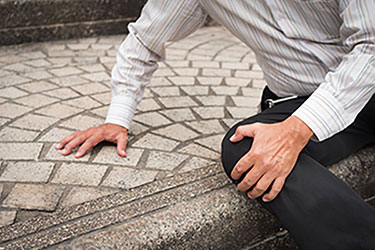Common Slip and Fall Injuries and Symptoms in California

Many people think of a slip and fall accident as minor, but statistics reported by the US Centers for Disease Control and Prevention (CDC) reveal otherwise.
In 2017, 8,591,683 people were treated in hospital emergency rooms for unintentional falls.
For all but two of the 10 age groups, slip and falls were the number one reason these individuals sought treatment; they ranked second for people aged 10 to 24 years old.
Though the CDC’s data doesn’t break down the exact type of bodily harm, there are some common slip and fall injuries you should note to protect yourself and your family.
You should also be aware that you may be entitled to compensation if you were hurt because of dangerous conditions on someone’s property. While a California slip and fall accident lawyer can offer a more detailed explanation, an overview of these incidents may be helpful.
Common Slip and Fall Injuries Types
Though every case is different, there are some types of bodily harm that tend to occur more frequently in these incidents. Some common slip and fall injuries, symptoms, and types include:
- Head injuries, such as a concussion or traumatic brain injury (TBI);
- Cuts and abrasions, which may occur due to sharp edges or surfaces;
- Wrist injuries, since you may instinctively throw your arms out to break a fall;
- Bruising, usually the result of striking something or being struck by an object;
- Muscle strains, sprained ligaments, and tendon injuries, often the result of twisting as you try to protect your body;
- Trauma to the neck, back, and spinal cord;
- Knee and ankle injuries;
- Bone fractures, which can cause long-term complications;
- Shoulder and hip injuries, especially dislocation; and,
- Soft tissue injuries, which present challenges because of the difficulties in diagnosis and treatment.
Liability in a Slip and Fall Accident Case
In general, a slip and fall incident is a type of personal injury case that’s based upon negligence. The specific legal concept behind such accidents is premises liability, which imposes a duty upon property owners. You may have a claim and be entitled to compensation by proving:
- A duty to keep the premises safe, an obligation that applies to all California property owners, operators, managers, landlords, tenants, or other parties in control of the premises;
- A breach of this legal duty, in which the responsible party failed to ensure the property was reasonably safe;
- A direct link between the breach of duty and the accident that caused your slip and fall injuries; and,
- Your physical, financial, and emotional losses that resulted from the accident.
It may be helpful to review some examples of slip and fall accidents that could entitle you to recover monetary damages under the theory of premises liability. A property owner could breach the legal duty to keep the premises reasonably safe by:
- Neglecting to clean up spills or make repairs to hazardous conditions;
- Allowing loose wiring, carpet, flooring, pavement, or other dangers to linger on the property;
- Failing to inspect the property to discover hazards that could pose a risk of injury;
- Not fixing broken staircases, handrails, or balconies;
- Refusal to comply with building codes established by federal, state, or local officials; or,
- Failing to put up a sign or barricade around dangerous conditions.
Compensation in Premises Liability Cases
Based upon the severe nature of slip and fall injuries, you could suffer significant losses after being hurt in an accident on the property.
Fortunately, California law may allow you to recover monetary damages, which typically come in two forms:
- Economic damages, such as medical bills, lost wages, and other out-of-pocket expenses; and,
- Non-economic damages, including pain, suffering, emotional distress, scarring, and other amounts representing your subjective losses.
Potential Challenges in a Slip and Fall Claim
Even when you prove the above four elements of a premises liability case, there are certain laws and legal issues that could present challenges. First, you should note the California statute of limitations, which requires you to file a lawsuit within two years after you suffered slip and fall injuries. Once this time period expires, you cannot sue the property owner to recover compensation for your losses.
In addition, California applies the rule of comparative negligence in premises liability cases. If you were at fault in any way in the accident that causes your slip and fall injuries, your monetary damages will be reduced on a percentage basis.
Discuss Your Legal Remedies with a Slip and Fall Accident Attorney in California
While this information on common slip and fall injuries may reduce the potential risks, it’s good to know that you have legal options as a victim. For more information on your rights and how premises liability claims work, please contact Starpoint LC, Attorneys at Law.
We can schedule a no-cost, no-obligation consultation to review your circumstances and determine the best strategy to proceed with your case.

